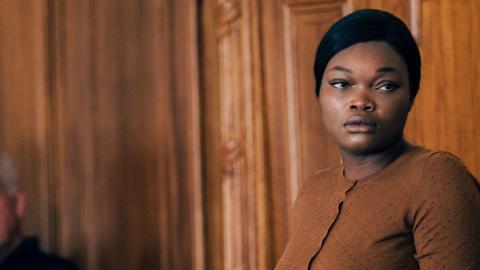SAINT OMER: A Stylish Narrative Debut

SAINT OMER
This review of Alice Diop's Saint Omer was written by David Vanden Bossche, PhD candidate in the Department of Communication Arts at UW-Madison. Saint Omer will screen on Thursday, February 16, at 7 p.m., in our regular Cinematheque venue, 4070 Vilas Hall, 821 University Avenue. Admission is free!
By David Vanden Bossche
Alice Diop came to prominence as a filmmaker award-winning crafting documentaries like Nous and La Mort de Danton in which African identity and the African diaspora were central themes. That approach certainly hasn’t changed for her new feature Saint Omer but this is the first time Diop is working with a more structured narrative that undergirds her thematic ponderings. The resulting film won a slew of awards, among them the prize for Best Screenplay at the Chicago International Film Festival and the award for Best Film at the Ghent Film Festival last October.
As if to illustrate that there is not a clear line that divides documentary work and fiction, Saint Omer opens, after a short ten second prologue, with a university lecture about the way in which art sublimates reality, a scene that uses Hiroshima, Mon Amour to make its point. The story Diop subsequently uses to sublimate reality is a fascinating tale that mirrors two African-European women: on one side is Rama (Kayije Kagame), a writer working on a new version of Euripides’ Medea. Seeking inspiration, the project leads her to attend a trial in the town of Saint Omer. On trial is the second female protagonist of this drama: Laurence Coly (Guslagie Malanda) who is being charged with the murder of her 15-month-old daughter, a case that has obvious parallels with Rama’s Greek tragedy of choice.
It takes a while before the movie reveals its full storyline to the viewer and even when it has done so, Diop opts for a pace that allows us to slowly take in all the complex elements of the unfolding trial. Using predominantly long takes, the camera explores the emotions on the characters’ faces but also lets the judicial details slowly unfurl themselves through testimonies. Out of these lengthy observations – a scarcely moving camera often keeps the image locked on a single face while we hear other voices contributing from offscreen – a richly textured account of complex and often perplexing events slowly develops. Diop opts for letting testimonies and interrogations play out mostly in real time, which means that the viewer is asked to adjust judgements and views along with the crowd in the courtroom.
Most striking as this trial unfolds is the way in which the directorial choices open up a second layer of meaning that finds its way to the surface through the reflective and contemplative style. Underneath what seems to be a simple formalist exercise in a time-tested format lies a much more poignant reflection on the warping of African traditions. In his book Moral Power: The Magic of Witchcraft, Professor Koen Stroeken addresses the way in which traditional African witchcraft has morphed into a violent hybrid with westernized conceptions of guilt and punishment. Without ever explicitly talking about Stroeken’s subject, Saint Omer still manages to make these changing traditions palpable to the viewer by subtly suggesting the shadow they cast over the trial proceedings.
The fact that the film succeeds in weaving these layers into the narrative is in no small way indebted to the superbly crafted screenplay that often smuggles small subtleties and telling details into lines of dialogue or seemingly redundant situations. In that way, scenes such as the one in which Laurence’s mother lectures Rama on what to eat and not to eat at lunch become much more important than they might initially seem and neatly tie into the undergirding themes.
The quality of the writing should not blind us though, to the splendidness equally displayed in the visual style of Saint Omer. Although never really vying for the viewer’s attention, the images shot by Diop and director of cinematography Claire Mathon are quietly powerful and overwhelming. Mathon has worked on films as different as Stranger by the Lake, Spencer, and two acclaimed collaborations with director Céline Sciamma: Portrait of a Lady on Fire and Petite Maman. Once again, the cinematographer finds the perfect pictorial style – albeit a very different one than in previous work – to best suit the narrative needs of the film. Alice Diop, for her part, has already revealed herself as a remarkably mature filmmaker, even at the relatively young age of 43. This first foray into fictional work – although her films have always eluded such easy categorizations – certainly bodes well for future endeavors.
